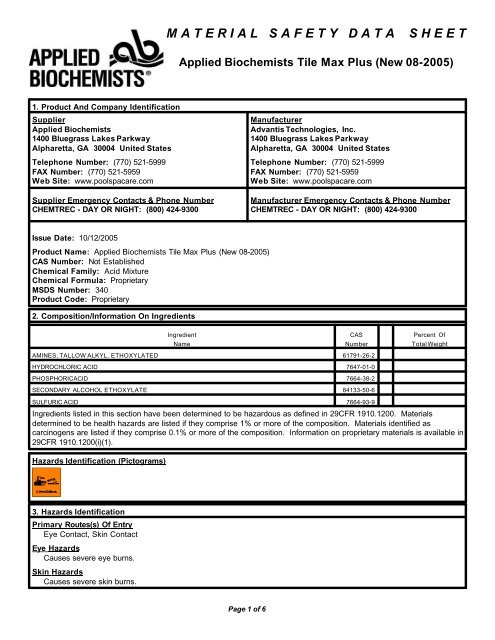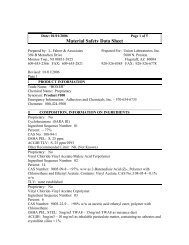Applied Biochemists Tile Max Plus - Pool Water Products
Applied Biochemists Tile Max Plus - Pool Water Products
Applied Biochemists Tile Max Plus - Pool Water Products
You also want an ePaper? Increase the reach of your titles
YUMPU automatically turns print PDFs into web optimized ePapers that Google loves.
M A T E R I A L S A F E T Y D A T AS H E E T<strong>Applied</strong> <strong>Biochemists</strong> <strong>Tile</strong> <strong>Max</strong> <strong>Plus</strong> (New 08-2005)1. Product And Company IdentificationSupplierManufacturer<strong>Applied</strong> <strong>Biochemists</strong>Advantis Technologies, Inc.1400 Bluegrass Lakes Parkway 1400 Bluegrass Lakes ParkwayAlpharetta, GA 30004 United StatesAlpharetta, GA 30004 United StatesTelephone Number: (770) 521-5999 Telephone Number: (770) 521-5999FAX Number: (770) 521-5959 FAX Number: (770) 521-5959Web Site: www.poolspacare.comWeb Site: www.poolspacare.comSupplier Emergency Contacts & Phone Number Manufacturer Emergency Contacts & Phone NumberCHEMTREC - DAY OR NIGHT: (800) 424-9300 CHEMTREC - DAY OR NIGHT: (800) 424-9300Issue Date: 10/12/2005Product Name: <strong>Applied</strong> <strong>Biochemists</strong> <strong>Tile</strong> <strong>Max</strong> <strong>Plus</strong> (New 08-2005)CAS Number: Not EstablishedChemical Family: Acid MixtureChemical Formula: ProprietaryMSDS Number: 340Product Code: Proprietary2. Composition/Information On IngredientsIngredient CAS Percent OfName Number Total WeightAMINES, TALLOW ALKYL, ETHOXYLATED 61791-26-2HYDROCHLORIC ACID 7647-01-0PHOSPHORICACID 7664-38-2SECONDARY ALCOHOL ETHOXYLATE 84133-50-6SULFURIC ACID 7664-93-9Ingredients listed in this section have been determined to be hazardous as defined in 29CFR 1910.1200. Materialsdetermined to be health hazards are listed if they comprise 1% or more of the composition. Materials identified ascarcinogens are listed if they comprise 0.1% or more of the composition. Information on proprietary materials is available in29CFR 1910.1200(i)(1).Hazards Identification (Pictograms)3. Hazards IdentificationPrimary Routes(s) Of EntryEye Contact, Skin ContactEye HazardsCauses severe eye burns.Skin HazardsCauses severe skin burns.Page 1 of 6
M A T E R I A L S A F E T Y D A T AS H E E T<strong>Applied</strong> <strong>Biochemists</strong> <strong>Tile</strong> <strong>Max</strong> <strong>Plus</strong> (New 08-2005)3. Hazards Identification - ContinuedIngestion HazardsCorrosive to living tissue.Inhalation HazardsMay cause severe allergic respiratory reaction.Signs And SymptomsIrritation of Eyes, Skin and Respiratory PassagesFirst Aid (Pictograms)4. First Aid MeasuresEyeIn case of contact, hold eyelids apart and immediately flush eyes with plenty of water for at least 15 minutes.Call aphysician or a poison control center immediately.SkinRinse the affected area with tepid water for at least 15 minutes.Get medical attention immediately if irritation(redness, rash, blistering) develops and persists.IngestionDO NOT INDUCE VOMITING. Drink large amounts of water. Contact a physician or poison control.InhalationIf inhaled, remove to fresh air. If breathing is difficult, give oxygen. Call a physician or a poison control centerimmediately.Fire Fighting (Pictograms)5. Fire Fighting MeasuresFlash Point: N/A °FExtinguishing MediaUse the appropriate extinguishing media for the surrounding fire.Fire Fighting Instructions<strong>Water</strong> can be used to cool and protect exposed material. Firefighters should wear self-contained breathing apparatusand full protective gear.6. Accidental Release MeasuresNeutralize spill area with soda ash or lime. Flood with water. Use appropriate containers to avoid environmentalcontamination. Use appropriate personal protective equipment (PPE).7. Handling And StorageHandling And Storage PrecautionsKeep out of reach of children. Do not store with alkalis.Page 2 of 6
M A T E R I A L S A F E T Y D A T AS H E E T<strong>Applied</strong> <strong>Biochemists</strong> <strong>Tile</strong> <strong>Max</strong> <strong>Plus</strong> (New 08-2005)7. Handling And Storage - ContinuedHandling PrecautionsAvoid contact with eyes. Avoid contact with skin and clothing. Wash thoroughly after handling.Storage PrecautionsAvoid contact with Alkalis, Amines, and Metals. Keep out of reach of children.Work/Hygienic PracticesUse safe chemical handling procedures suitable for the hazards presended by this material.Protective Clothing (Pictograms)8. Exposure Controls/Personal ProtectionEngineering ControlsLocal exhaust acceptable. Special exhaust not requiredEye/Face ProtectionSafety glasses with side shields or goggles recommended.Skin ProtectionChemical-resistant gloves.Respiratory ProtectionNone normally required.Ingredient(s) - Exposure LimitsHYDROCHLORIC ACIDACGIH TLV-CEILING 5 ppmOSHA PEL-CEILING 5 ppmPHOSPHORIC ACIDACGIH TLV-STEL 3 mg/m3ACGIH TLV-TWA 1 mg/m3OSHA PEL-TWA 1 mg/m3SULFURIC ACIDACGIH TLV-STEL 3 mg/m3ACGIH TLV-TWA 1 mg/m3OSHA PEL-TWA 1 mg/m39. Physical And Chemical PropertiesAppearanceamber, viscous liquidOdorMildChemical Type: MixturePhysical State: LiquidMelting Point: n/a °FBoiling Point: 212 °FSpecific Gravity: 1.1-1.2Percent Volitales: NOT DETERMINEDPacking Density: NOT DETERMINEDVapor Pressure: NOT DETERMINEDPage 3 of 6
M A T E R I A L S A F E T Y D A T AS H E E T<strong>Applied</strong> <strong>Biochemists</strong> <strong>Tile</strong> <strong>Max</strong> <strong>Plus</strong> (New 08-2005)9. Physical And Chemical Properties - ContinuedOdor - ContinuedVapor Density: >1pH Factor: 0-2Solubi l i ty: Soluble in <strong>Water</strong>Viscosi ty: NOT DETERMINEDEvaporation Rate:
M A T E R I A L S A F E T Y D A T AS H E E T<strong>Applied</strong> <strong>Biochemists</strong> <strong>Tile</strong> <strong>Max</strong> <strong>Plus</strong> (New 08-2005)15. Regulatory Information - ContinuedIngredient(s) - U.S. Regulatory Information - ContinuedSARA Title III - Section 313 Form "R"/TRI Reportable ChemicalSARA - Acute Health HazardSARA - Chronic Health HazardSARA - Fire HazardSARA - Reactivity HazardIngredient(s) - State RegulationsHYDROCHLORIC ACIDNew Jersey - Workplace HazardNew Jersey - Environmental HazardNew Jersey - Special HazardNew Jersey - TCPA Extraordinarily Hazardous SubstancePennsylvania - Workplace HazardPennsylvania - Environmental HazardMassachusetts - Hazardous SubstanceNew York City - Hazardous SubstanceSULFURIC ACIDNew Jersey - Workplace HazardNew Jersey - Environmental HazardNew Jersey - Special HazardPennsylvania - Workplace HazardPennsylvania - Environmental HazardCalifornia - CalARP Table 3 Regulated SubstanceMassachusetts - Hazardous SubstanceNew York City - Hazardous SubstanceCanadian Regulatory InformationClass D, Div 1a - Poisonous or Infectious Material: immediate and serious toxic effectsClass D, Div 2a - Poisonous or Infectious Material: other toxic effectsClass D, Div 2b - Poisonous or Infectious Material: other toxic effectsClass E - Corrosive MaterialWHMIS - Canada (Pictograms)NFPA12 2HMISHEALTH 3FLAMMABILITY 0REACTIVITY 1PERSONAL PROTECTION X16. Other InformationRevision/Preparer InformationMSDS Preparer: JHWThis MSDS Superceeds A Previous MSDS Dated: 05/09/2005Page 5 of 6
M A T E R I A L S A F E T Y D A T AS H E E T<strong>Applied</strong> <strong>Biochemists</strong> <strong>Tile</strong> <strong>Max</strong> <strong>Plus</strong> (New 08-2005)DisclaimerAlthough reasonable care has been taken in the preparation of this document, we extend no warrantiesand make no representations as to the accuracy or completeness of the information contained therein,and assume no responsibility regarding the suitablility of this information for the user's intended purposesor for the consequences of its use. Each individual should make a determination as to the suitability ofthe information for their particular purposes(s).<strong>Applied</strong> <strong>Biochemists</strong>Printed Using MSDS Generator 2000Page 6 of 6
















